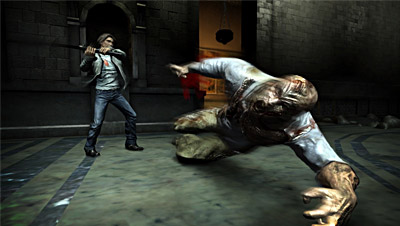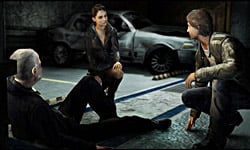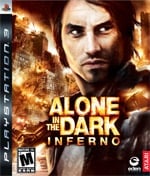Still a Mess
Alone in the Dark is one of those games that demos well. When the first snippets of gameplay started to crop up on the Internet (always guided by a member of the development team) there was a pairing of genuine hope with the hype. Seeing the main character repel down the side of a crumbling building and combine a can of mosquito spray with a lighter to form a makeshift flamethrower made for a nice series of gameplay vignettes, showing that a lot of creative potential was going into the game.

Yet, when Alone in the Dark hit its first batch of systems (the 360, PS2, Wii, and PC), critics were sharp in their commentary, giving the horror title mixed marks, complimenting some of its innovative intentions, but condemning much of their implementation. The developer – Eden Games – decided that the PS3 version would be put on hold, so they could address control and camera issues, as well as fine-tune particular sections of the game.
Here, we pickup on a patch mentality: the developers assumed the original game was fine from a core standpoint, but little issues held it back. The solution? Tweak here and there and you’ve got the game they always intended to deliver. Eden Games’ delay is much appreciated – a fair amount has been improved, but this is essentially the same game released months ago. So, while camera problems have been fixed and controls re-mapped, the same broken, cliché-laden story and mundane gameplay still permeates the title.
Alone in the Dark’s introductory segment serves as an example of when faulty immersion butts its head against interactive storytelling. The protagonist – Edward Carnby, an amnesiac – awakes in a bed, only to find he can’t move and his vision fogged over. Bad guys, dressed in black, toting guns, yell orders at Edward, but since he can’t move, this serves as an in-game cutscene. You only have one control option: by clicking in the analog sticks you can make Edward blink, clearing up his view. At first this seems like a clever bit of interactivity – similar to controlling your breathing and regulating fear in Indigo Prophecy. However, in Indigo Prophecy there was consequence: lose control and your character passed out. Here, you are constantly clicking in the sticks so you can see a generic cutscene unfold, moving the mechanic from the clever category to one of annoyance rather quickly. This situation – of new ideas poorly implemented – continually crops up throughout the course of play.

Much of Alone in the Dark is framed with giant set pieces. A good movie can use a set piece well – it can serve as proper dressing, allowing you to get a better context for a particular scene. Here, set pieces are used in their most basic form – they don’t really enhance or diminish what’s going on. Instead, they merely assemble cool backdrops that do little to contribute to the game. For example, Edward climbs down the sides of crumbling buildings and jumps from high ledges throughout the game, but there’s never any real sense of danger or urgency. Sure, what’s going on in the immediate background – like raging fires – seems dangerous, but most of the time Edward finds himself in a safe patch of the foreground. To hammer home that these set piece scenes are important, the camera frequently switches to a slow-mo setting nearly every time you make a leap. Whether you’re jumping over a 3-foot gap or vaulting a taxi cab over a seemingly bottomless pit, Alone in the Dark is reminding you that you’re experiencing an action moment. If the mechanic was used sparingly, it might have worked well, but its continual use dilutes whatever initial potency it had.
A good chunk of originality is derived from the way you control Edward. For example, in a typical survival horror game combat is mapped to a trigger button – used to lock-on to a target – and then a single button press is paired with that to dish out damage. Here, there’s still the initial use of the trigger, but the right analog stick is used to manipulate the melee object in question. Whether you’re welding a chair or a lead pipe, you have two options: push the stick from left to right to swing horizontally or push it up and down to smash. This all sounds well and good – supposedly giving you more control over Edward’s actions – but it never rings solid. A simple button press would have been the route to go as it gives an immediate sense of cause and effect, whereas this scheme feels wobbly, giving combat a floaty, unsatisfying feel.

Where the originality pays off (to some extent) is the inventory and customization system. Items are displayed in your jacket and split into two classes: those that you can grip in your right hand and those you can place in your left. From the jacket, you can equip different sets of items – like a flashlight and a handgun – or combine two items together. You may combine a can of mosquito spray and some handkerchiefs to make a Molotov Cocktail or tape a glow stick to an object in the environment so you can see better. The system doesn’t exactly let you pull off MacGyver-like inventions, but it does allow you to create some interesting combos. The problem with all those item combinations is their end result: most of the time you’re creating stuff that lights other things on fire.
Fire, without a doubt, is Alone in the Dark’s gaming crutch. Edward is either putting out fires with a seemingly always available fire extinguisher or starting fires. The reason to use fire is simple: it’s the only way to kill enemies. Shoot an enemy over-and-over again – they’ll eventually get up. Hit them with a flaming chair and they’ll instantly evaporate. As the game grinds on, fire becomes a nagging commodity. Edward is constantly searching for ways to light stuff on fire – whether this means sticking a broom handle into a small patch of fire or shooting explosive bottles. Perhaps the silliest implementation of fire in Alone in the Dark comes from the item combo system. You can pour liquor on bullets, effectively making them fire rounds, which you then use to shoot enemies.
Survival horror was mentioned in relation to combat mechanics, but it doesn’t define Alone in the Dark’s genre. Instead, the game is better classified as a supernatural thriller and the developers probably wouldn’t mind that label as the DVD-like chapter system employed gives a movie vibe. Alone in the Dark is segmented into eight episodes and those episodes are made up of sequences. At any time you can fast forward or rewind. If you want to jump ahead an entire episode or two – effectively skipping hours of gameplay – you can, or if you just want to skip to the next sequence, forfeiting only about 10 minutes of gameplay, you can do that too.

The ability to jump back-and-forth in the story continuum is handy, as there are many segments that are so poorly designed that you’ll want to skip them and you’ll be grateful the option is there. One such sequence turns Central Park into a race track that you must zip around while avoiding bats that can somehow pickup your car. Another Central Park segment requires you to go on a fetch quest, killing a certain type of enemy over-and-over. There’s even a bizarre portion that mimics the forklift, box moving mini-game from Shenmue.
Many of these deficiencies wouldn’t carry so much weight if Alone in the Dark had a good story to tout. However, the script (centering on anything and everything Satanic) runs from juvenile – with characters constantly swearing – to predictable. It all leads up to a set of endings that seem like they were thrown in at the last minute. Neither one gives a proper sense of conclusion. In fact, both, in a way, negate all the work you’ve accomplished in the game, rendering them almost useless.
What about all the fixes promised for this version? Well, the camera definitely works better, giving you a better view from third-person and the ability to map item combinations – like the ever useful fire bullets – to the D-pad, which cuts down on item prep time. However, for a definitive version of a game, there are still technical problems. Edward fell through the world on more than one occasion, resulting in some very weird death animations – not something you’d expect from a game that’s been delayed so many times to assure a certain level of quality.
Alone in the Dark is ultimately a lesson in good intentions gone awry. Nearly all of its novel ideas misfire. What’s so interesting about Inferno is the mentality that a patch was all that was needed to make a better game. The original was defined by a lackluster story, awkward controls, and merely okay gameplay – that’s not a formula that needs a few tweaks, it’s one that should be scrapped entirely. Nevertheless, Inferno is the definitive version of Alone in the Dark, but that’s not the biggest compliment one can give.
RATING OUT OF 5 RATING DESCRIPTION 3.0 Graphics
Lighting work – from shadows to fire effects – is superb, yet there are plenty of bland textures and issues with screen-tearing and anti-aliasing. It doesn’t help that this is supposed to be the “patched’ version and the character will still glitch through the environment. 2.5 Control
Aiming never feels as spot-on as it should and the dual-analog stick melee combat system is very uncomfortable. Setting up favorites (all handled via the D-pad) works well. 2.5 Music / Sound FX / Voice Acting
Aside from the occasional epic, choir-filled music track, there really isn’t much to like. The voice acting – which is paired with a terrible script – is bad from beginning to end. 2.0 Play Value
The story is cliché and annoying rather than scary; the controls are unnecessarily difficult; and this version – supposedly “fixed” – has so many technical and design issues that it renders the game a chore to play. 2.4 Overall Rating – Poor
Not an average. See Rating legend above for a final score breakdown.
Game Features:
